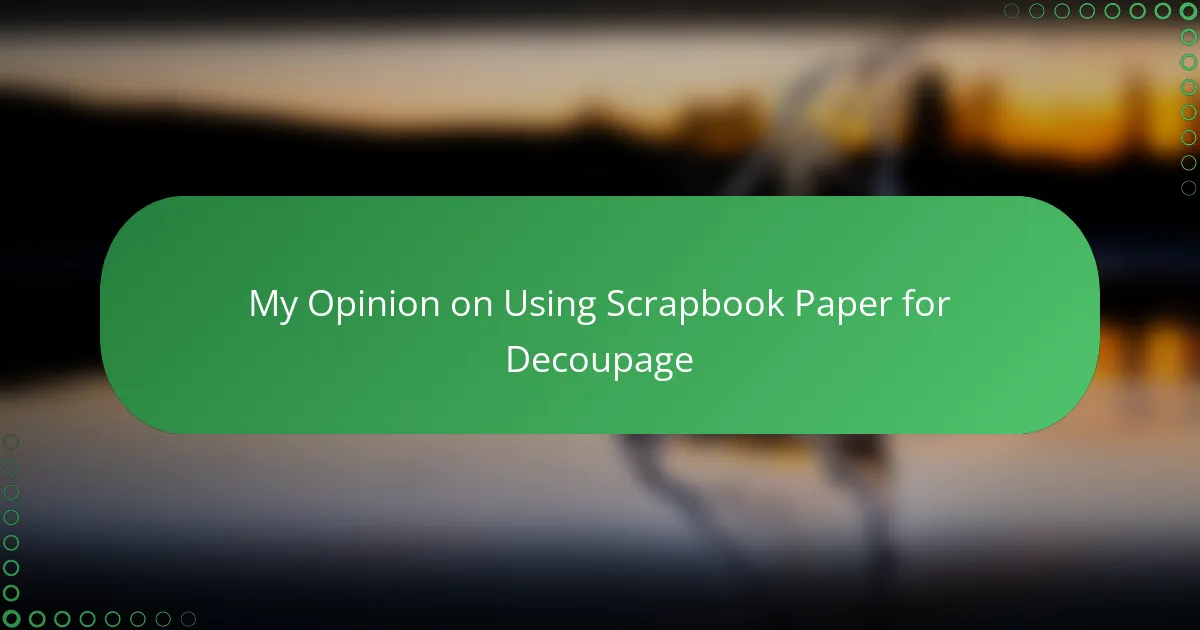Key takeaways
- Handmade paper crafts foster a unique connection, encouraging creativity and personal storytelling through tactile art.
- Choosing the right paper, especially scrapbook paper, significantly affects the outcome of decoupage projects, balancing flexibility and strength.
- Techniques such as using manageable paper pieces and applying thin layers of glue can enhance the quality of the finished work.
- Common challenges with scrapbook paper include thickness, adhesive issues, and color transfer, highlighting the importance of careful material selection.

Introduction to Handmade Paper Crafts
Handmade paper crafts have always fascinated me because they blend creativity with a hands-on experience that digital projects simply can’t match. There’s something deeply satisfying about transforming simple sheets of paper into beautiful, tactile art. Have you ever felt that unique connection between your hands and your craft, where every fold, cut, or brushstroke carries a bit of your personality?
Over the years, I’ve noticed how handmade paper crafts invite you to slow down and appreciate the materials and techniques involved. It’s almost therapeutic—each project becomes a small journey filled with trial, error, and eventual delight. This connection to the process makes every finished piece feel truly special, almost like a personal story told through paper.
What makes handmade paper crafts stand out for me is their incredible versatility. From delicate origami to bold mixed-media designs, the possibilities seem endless. This sense of freedom encourages experimentation, which keeps the craft exciting and fresh every time I sit down to create.

Understanding Decoupage Techniques
Decoupage, at its core, is all about layering and sealing paper onto surfaces to create beautiful, textured designs. I remember the first time I tried it—it felt like painting without a brush, using paper instead. Have you ever been surprised by how just a few layers of paper and glue can completely transform an ordinary object?
The technique involves careful placement of paper cutouts and smoothing out wrinkles, which requires a bit of patience and a gentle touch. I find this part surprisingly calming, almost like a mindful moment amid a busy day. It’s rewarding to see the pattern come alive as each layer dries and melds seamlessly.
One tip I’ve learned is that the choice of adhesive greatly affects the final look—some give a glossy finish, others matte, and each creates a different mood for your piece. Understanding these subtle variations has definitely improved my projects and made me appreciate the craft’s nuances even more. Have you noticed how small details like this can make a big difference?
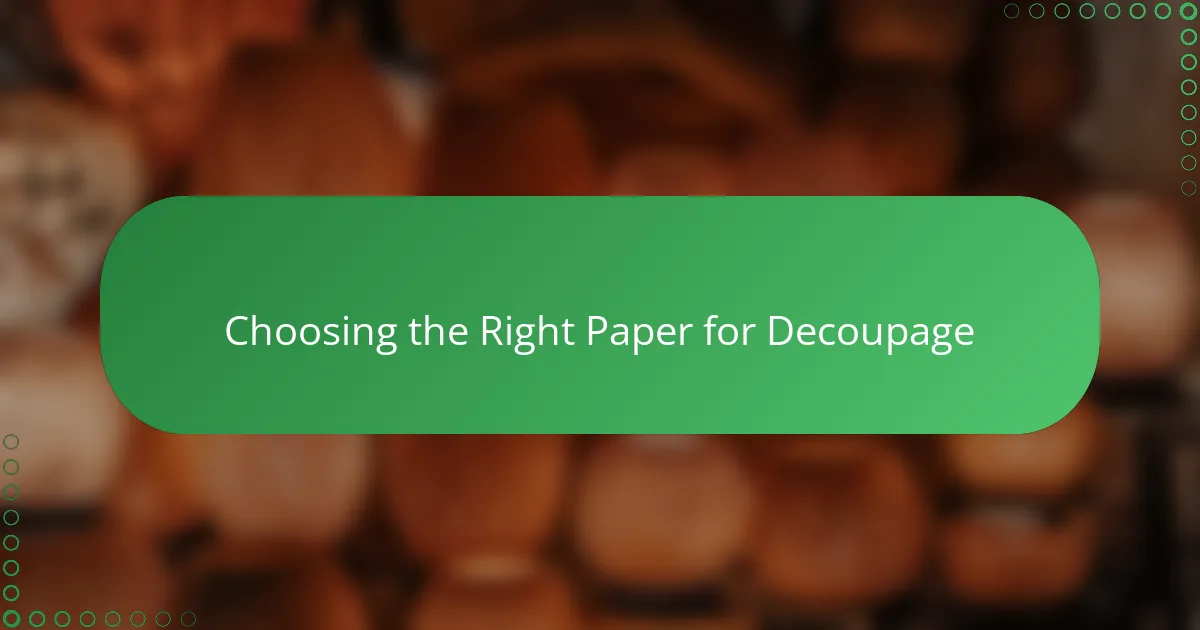
Choosing the Right Paper for Decoupage
Choosing the right paper for decoupage can totally change the way a project turns out. I’ve found that not all papers behave the same—some are too thick and wrinkle easily, while others are just too fragile to handle multiple glue layers. Have you ever tried working with a paper that just won’t cooperate? It’s frustrating, but it taught me the importance of picking a paper that balances flexibility and strength.
When I started experimenting, I often underestimated how the texture and weight of paper affect the final look. Scrapbook paper, for instance, usually hits the sweet spot for me—it’s sturdy enough to avoid tearing but thin enough to mold smoothly over curved surfaces. Plus, its vibrant patterns can add an extra dimension without needing extra paint or embellishments. Don’t you love it when your materials do some of the creative work for you?
I also come to appreciate how the absorbency of the paper plays into the drying and sealing process. Papers that soak up too much glue can look blotchy or become brittle, and that always puts a damper on the finished piece. Finding the right balance, where the glue seals the paper without overwhelming it, has made my decoupage experience far more enjoyable. What kind of paper have you found to work best when layering designs?
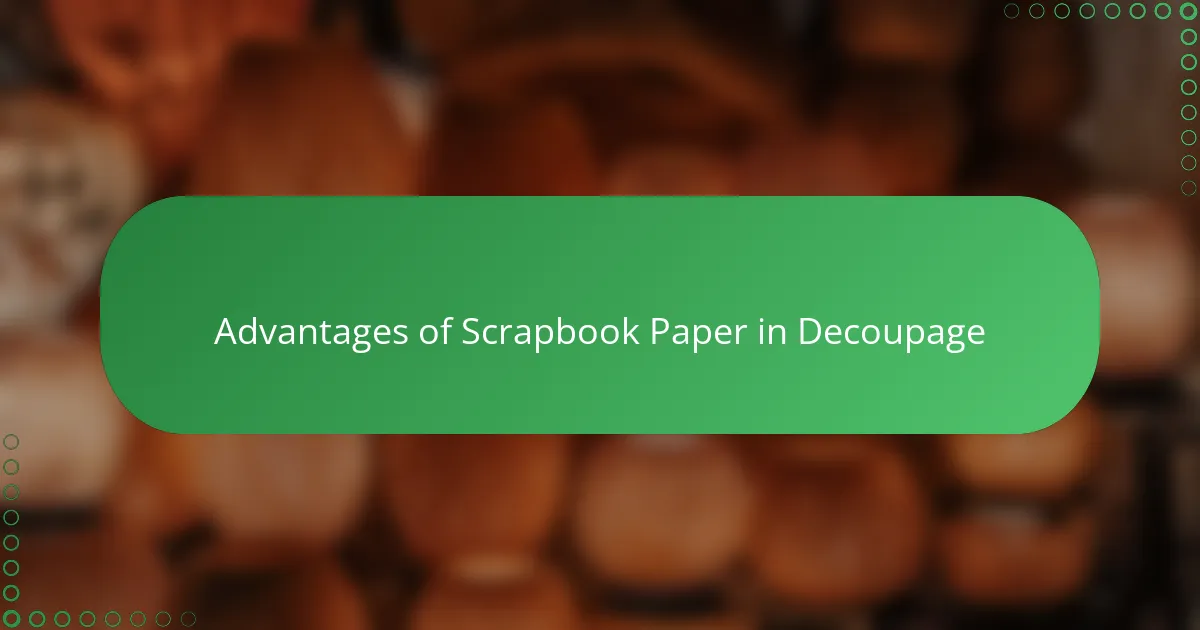
Advantages of Scrapbook Paper in Decoupage
One of the things I love most about using scrapbook paper for decoupage is its incredible variety of patterns and colors. It feels like having an entire palette at your fingertips—whether you want something vintage, floral, or modern geometric. Have you ever found a pattern that perfectly matched the vibe you were going for? That instant visual harmony makes the creative process so much more joyful.
Another advantage is how scrapbook paper handles when glued down. In my experience, it’s sturdy enough to resist tearing but still flexible enough to smooth out over complex shapes without a fight. That balance is tricky to find, and scrapbook paper nails it every time for me. It’s almost like the paper is collaborating with you, bending just enough to help the design take shape beautifully.
Plus, the finish on scrapbook paper often gives a polished look right away, meaning I don’t have to use extra paint or lots of layers of glue to seal the design. This makes my projects less messy and speeds up drying time, which I appreciate when I’m excited to see the finished result quickly. Don’t you find that when your materials work efficiently, the whole craft session feels more rewarding and less like a chore?
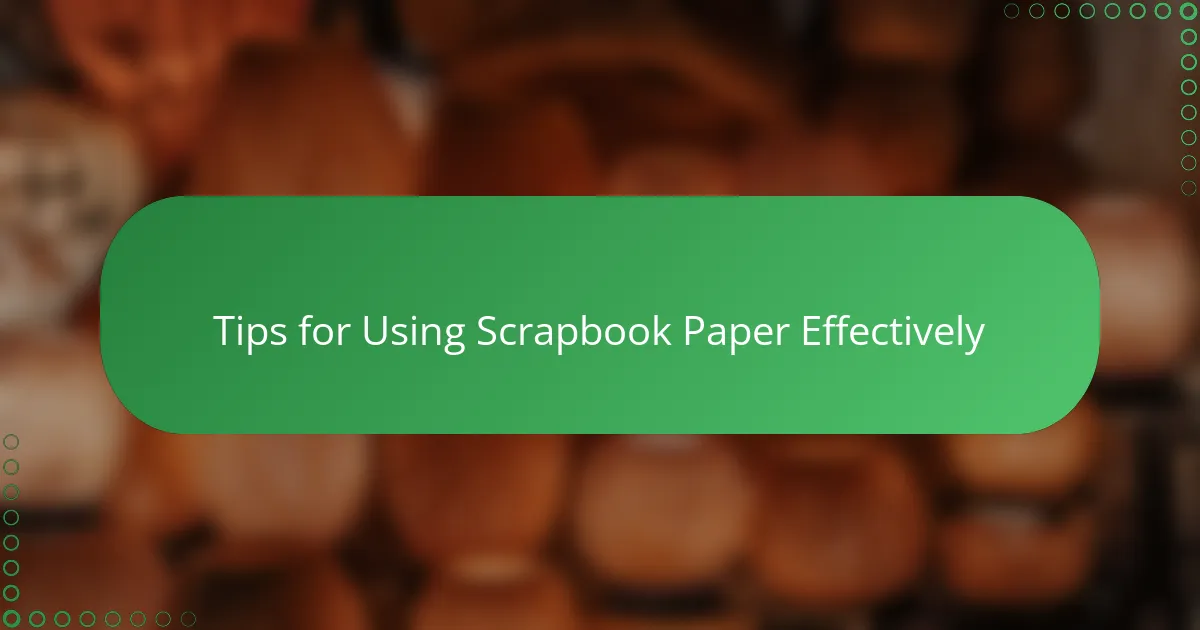
Tips for Using Scrapbook Paper Effectively
When working with scrapbook paper in decoupage, I’ve found that cutting the paper into manageable pieces first really helps. It’s much easier to handle and position smaller sections without tearing or wrinkling the edges. Do you ever get frustrated when a large sheet just won’t lay flat? Breaking it down can save a lot of headaches.
Another tip I swear by is using a soft brush to apply glue in thin, even layers. It keeps the paper from soaking up too much adhesive, which can cause bubbling or discoloration. I remember one project where I went too heavy-handed—lesson learned. Have you noticed how a delicate touch makes all the difference in the final texture?
Finally, I always like to let each layer dry completely before adding the next. I know it requires a bit more patience, but it’s worth it because the layers don’t smudge or peel later on. Waiting feels a little like investing in quality time with your craft, don’t you think? It’s this rhythm of creating and pausing that makes the process so enjoyable for me.
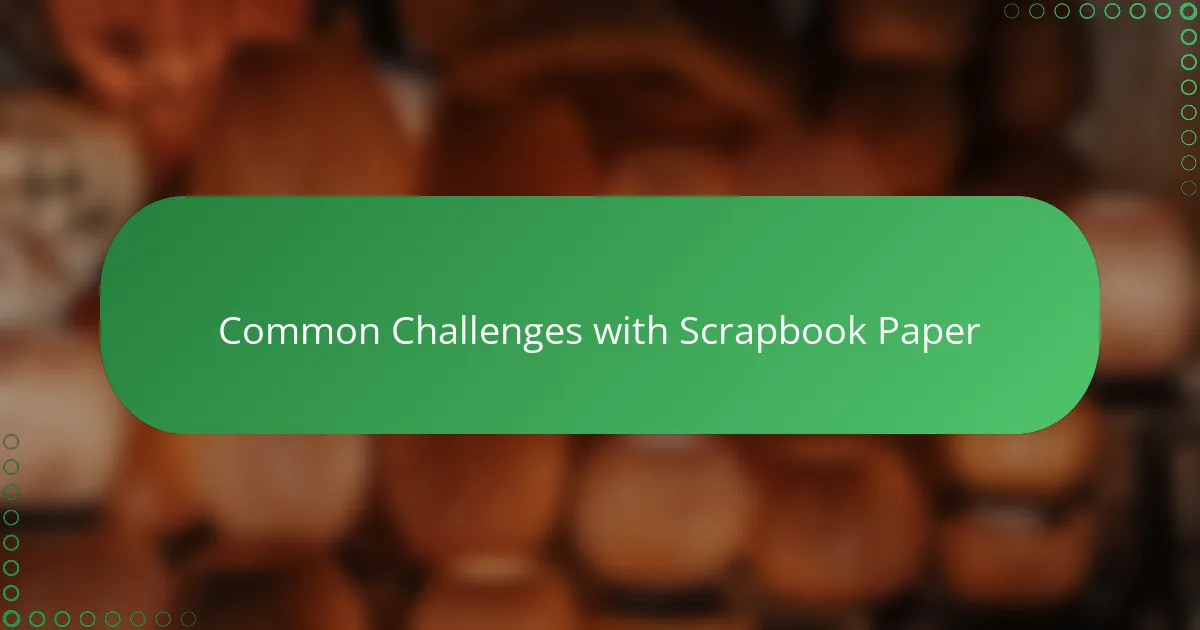
Common Challenges with Scrapbook Paper
Scrapbook paper, while versatile, does come with its quirks that can catch you off guard. I’ve often struggled with its thickness—some sheets are just a bit too thick, making it tricky to get a smooth finish without wrinkles or bubbles. Have you ever tried smoothing out a stubborn fold, only to realize the paper resists every gentle push? It’s a frustrating moment, but it taught me to be more patient and gentle with the process.
Another challenge I’ve encountered is the finish of scrapbook paper. Because some have glossy coatings, glue doesn’t always adhere evenly, causing patches that look blotchy or feel tacky. It’s funny how something as simple as paper texture can turn a project from sleek to messy in minutes. Have you noticed that the glue sometimes pools or wrinkles on these surfaces? Knowing this helps me pick my papers more carefully now.
Lastly, color transfer can be a hidden nuisance. I remember a time when vibrant scrapbook paper bled its ink onto lighter surfaces during sealing, ruining the look I’d worked so hard to achieve. Have you ever had to redo parts of a project because colors ran unexpectedly? It’s a reminder that not all scrapbook papers are created equal—testing a small piece beforehand has saved me from many headaches since.
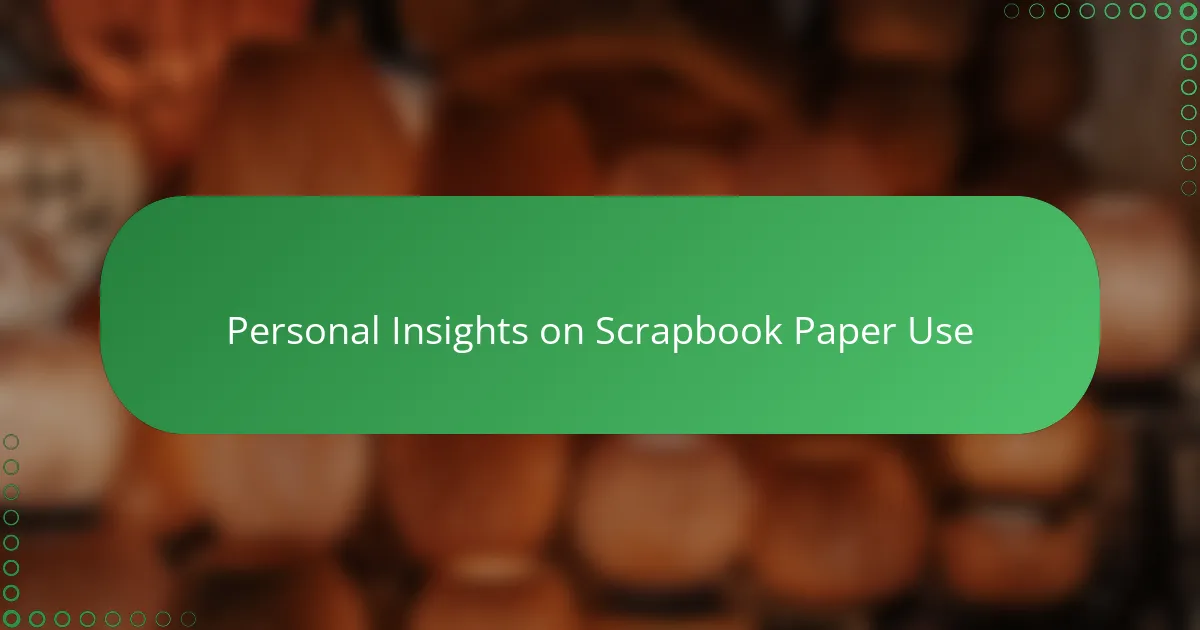
Personal Insights on Scrapbook Paper Use
Whenever I use scrapbook paper for decoupage, I’m struck by how its patterns seem to tell stories on their own. It’s like each sheet carries a bit of personality that seeps into my work, making every project feel genuinely unique. Have you ever noticed how just the choice of paper can change the mood of an entire piece?
One thing I’ve learned is that scrapbook paper’s reliability is both a blessing and a challenge. I recall a project where the paper’s thickness was perfect for smooth curves, and it felt like the material was working with me, not against me. Yet, other times, I’ve wrestled with sheets that just didn’t want to lay flat—those moments definitely test my patience and finesse.
I also appreciate how scrapbook paper often reduces the need for extra embellishments. Knowing that the paper’s colors and textures will shine through without much effort keeps me motivated and less overwhelmed. Isn’t it wonderful when your materials do part of the creative heavy lifting? That ease invites me to focus more on the fun parts of design and less on fixing mistakes.
